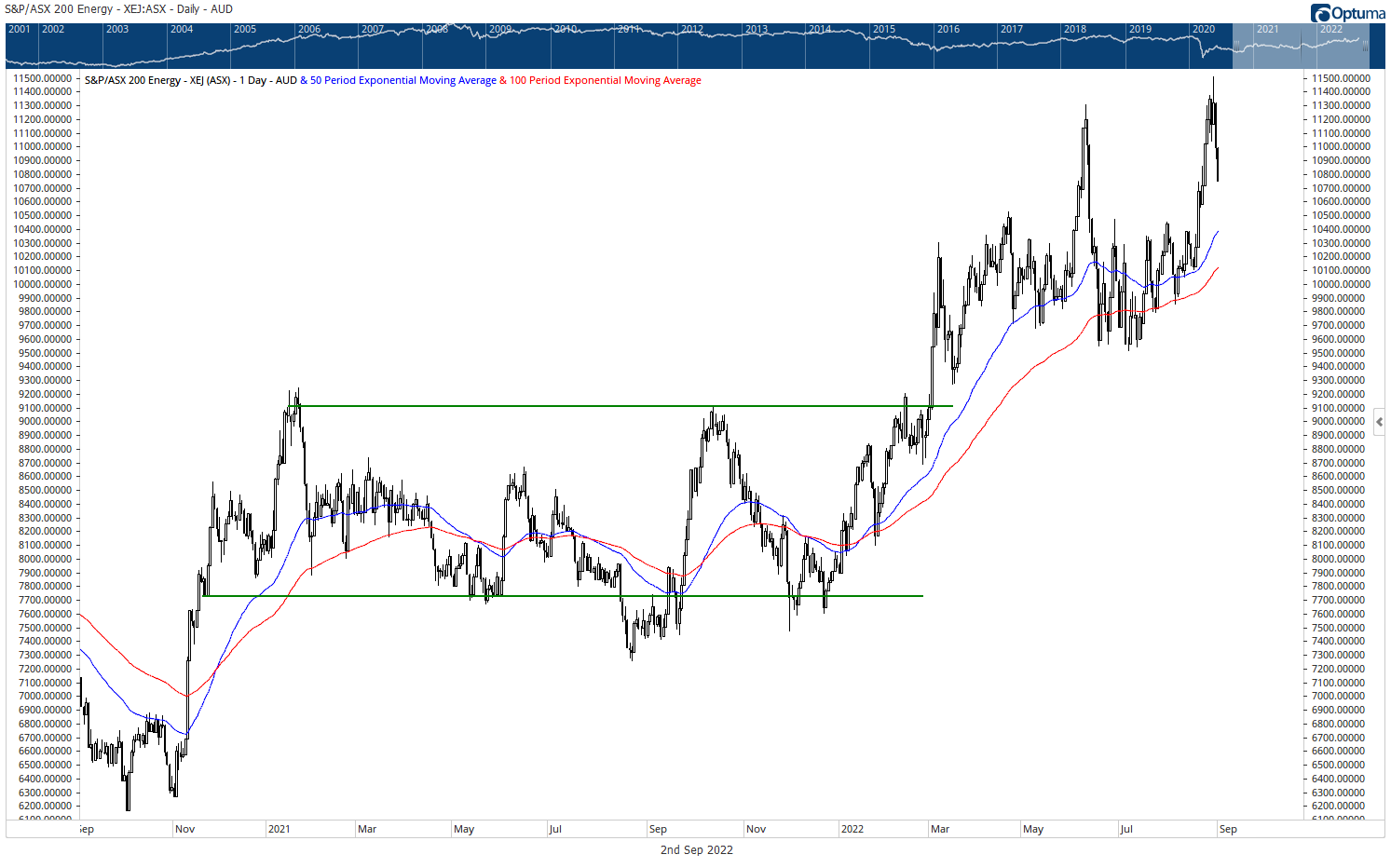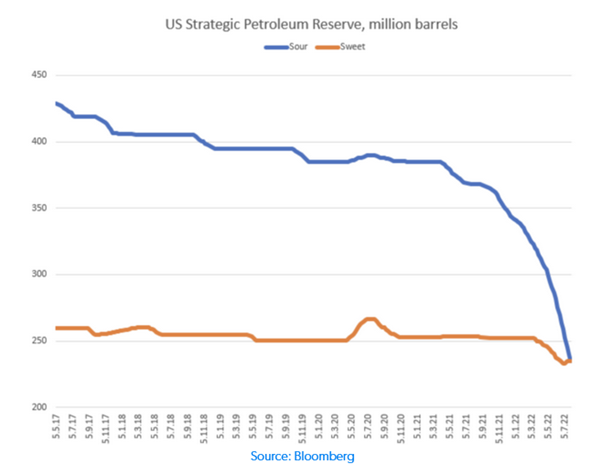America’s shrinking petroleum reserve, and why you need to buy the energy correction
In my past few Livewire articles, I argued that the rally that was underway since June was a bear market rally.
Over the past week, global equity markets have turned back down sharply. The bear trend is still in effect.
How long this will continue is anyone’s guess. The Fed is prepared to sacrifice the economy and asset prices in its fight against inflation.
The simple solution is "don't fight the Fed".
One area of the market that has held up quite well though is energy. The chart below shows the ASX200 Energy index, and as you can see it's had a strong 2022 so far.

But oil prices are now correcting sharply. US oil prices fell another 3.5% overnight to trade around US$86.50. This could lead to a deeper pullback in energy stocks in the months ahead. In my view, you should use any such correction to accumulate a long-term position in energy.
To understand why, you have to go back to the 1970s…
In October 1973, Syria and Egypt launched a surprise attack on Israel. In response, US President Richard Nixon authorised the supply of weapons to Israel.
The Organization of Arab Petroleum Exporting Countries (OAPEC), a subset of OPEC formed in 1968, retaliated by increasing oil prices by 70% and cutting production by 5%.
This didn’t dissuade Nixon, who asked Congress to authorise US$2.2 billion in aid to Israel. It triggered an extreme response from OAPEC — a total oil embargo on the US.
Supply, already tight given strong demand, and the rise of a culture built around the ‘automobile’, was crunched. As a result, prices soared even further. The US economy plunged into recession.
Petrol shortages were widespread, leading to stations around the country displaying sold out signs.
While OAPEC lifted the embargo by March 1974, it profoundly affected US energy security.
President Ford established the Strategic Petroleum Reserve (SPR) in 1975. In 1977, the Department of Energy acquired several existing salt caverns along the Gulf of Mexico to serve as storage sites.
The SPR now consists of 60 salt caverns. According to the US Department of Energy, ‘each cavern is cylindrical in shape with an average diameter of about 200 feet and a height of 2,550 feet’.
The caverns have a storage capacity of 713.5 million barrels.
Now, you’ve probably heard about the SPR before. What you may not know, however, is that President Biden has been using it to increase supply since March this year, to get petrol prices and inflation down ahead of the mid-term elections in November.
As of 26 August, the SPR’s holdings, at 450 million barrels, are at their lowest since 1985! It’s declined by 171 million barrels in the last 12 months alone, and it’s going lower in the months ahead.
How did it get this way?
When in trouble, blame Putin
On 1 March, the US committed to releasing 30 million barrels of oil from the SPR in response to the Russian invasion of Ukraine. Other International Energy Agency (IEA) members also agreed to release 30 million barrels from their strategic reserves.
But that was just the start. On 31 March, the Biden Administration issued a statement in response to ‘Putin’s price hike at the pump’:
‘After consultation with allies and partners, the President will announce the largest release of oil reserves in history, putting one million additional barrels on the market per day on average – every day – for the next six months. The scale of this release is unprecedented: the world has never had a release of oil reserves at this 1 million per day rate for this length of time. This record release will provide a historic amount of supply to serve as bridge until the end of the year when domestic production ramps up.’
A week later, the IEA issued this statement:
‘Over the next six months, around 240 million barrels of emergency oil stocks, the equivalent of well over 1 million barrels a day, will be made available to the global market.’
The 31 March announcement called for a release of reserves for six months. That would put the end date for September. But another announcement in July said the releases would continue until the end of October.
Just in time for the crucial mid-term elections that start on Tuesday, 8 November.
Call me cynical, but the timing is interesting, is it not?
I mean, just take a look at the graph below:

It shows the two types of oil held by the SPR — medium sour (blue line) and light sweet (orange line).
Medium or light refers to the oil’s density, while sour or sweet refers to its sulphur content.
Medium sour oil traditionally comes from the Middle East, Russia, and Venezuela — markets the US has imported from heavily over recent decades.
For this reason, US refineries are engineered to process this type of oil into gas (or petrol, as we call it).
Over the past year, 85% of oil sold by the SPR has been medium sour. The stockpiles of this crucial oil have plummeted.
This huge release has little to do with replacing Russian oil (which is still finding its way onto global markets) and everything to do with getting prices at the pump (and inflation) down in time for the elections.
By the time the elections come around, according to energy analyst Javiar Blas, the SPR will shrink to just 358 million barrels, down from 621 million barrels a year ago.
That’s a 40-year low!
Bottom of the barrel
But it’s worse than that. By the end of October, it’s estimated that stockpiles of medium sour crude will be just 179 million barrels. To put that into perspective, from June 2021 to October 2022, the US will have likely sold down 180–190 million barrels of medium sour.
In other words, there’s very little firepower left, short of draining the reserve completely.
And guess what happens when you (literally) get to the bottom of the barrel? You need to start filling it up again for when a real emergency occurs.
So let’s recap…
The US government has injected more than 200 million barrels of oil into the market, mostly over the past six months, in an effort to get petrol prices down. The US strategic petroleum reserve will be half empty by the end of October.
The rest of the world is also chipping in, producing the largest coordinated oil reserve release in history.
Normally, in the Northern Hemisphere, oil inventories build during the first six months of the year, then draw down over the second half as cold weather sets in.
This year, the inventory build has only been half of what it normally is. And that’s only because of the coordinated releases from SPR stockpiles. Without this artificial supply, inventories have actually declined!
On the demand side, the US Federal Reserve (and just about every other central bank in the world) is deliberately engineering a slowdown to get inflation (and, by implication, energy prices) down.
Yet, despite all this, the US benchmark oil price continues to trade around US$90/bbl. Sure, it could fall further in the short term as the Fed smashes the economy with tighter monetary policy.
But the authorities have thrown the kitchen sink at the oil price, and it’s barely flinched.
The question as to why is a story for another day. Let’s just say it has to do with government incompetence and climate zealotry. Putting all your chips in a technology that is decades away from producing reliable energy is just plain dumb.
And we’ll all pay the price for it.
That’s why smart investors must hold an overweight position in energy stocks for the next five years or so.
Never miss an insight
If you're not an existing Livewire subscriber you can sign up to get free access to investment ideas and strategies from Australia's leading investors.
And you can follow my profile to stay up to date with other wires as they're published – don't forget to give them a “like”.
2 topics

